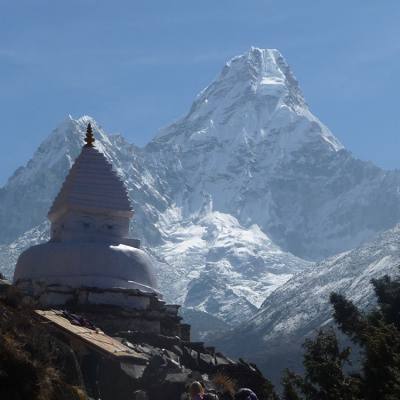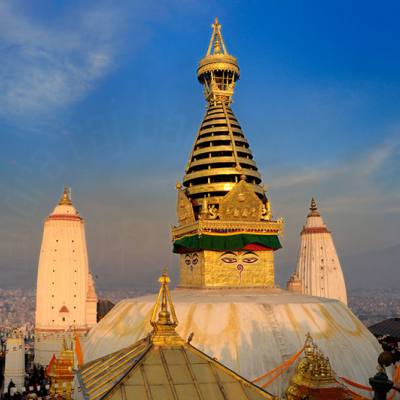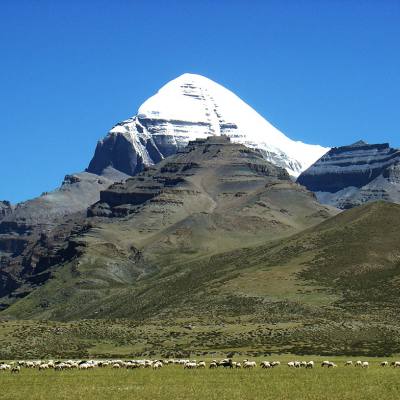Maghe Sankranti: (January – February)
In the holy month of Magh (local month) the sun enters the southern hemisphere and the days begin to grow longer and warmer. People take early morning baths in the holy river, visit the shrines of Vishnu and offer fowers, incense and food to him. They enjoy feast in along with special local food chaku (made of molasses), ghee (refined butter), tarul (wild yam).
Basanta panchami & Saraswati Puja: (February - March)
Basant Panchami is celebrated to mark the beginning of spring. Crowds gather at Royal Palace (inside the Kathmandu’s old Royal Palace in Durbar Sqaure area) with a holy presence of His Majesty the King and other dignitaries to welcome the new season accompanied by a band plays traditional songs of spring. Saraswati Puja: The same day, the local people get involved in a holy worship of the goddess of learning the Saraswati by the students, artists, musicians and teacher. Particularly, the day is holiest for the young children who are taken the temple of Saraswati where they make the children begin to learn the alphabets.
Maha Shivaratri: (February)
This is the night of Shiva. The highest Hindu god who is worshipped by the Hindus throughout the India sub-continent. Specifically, thousands of pilgrims gather at the Pashupatinath temple in Kathmandu from all over India and Nepal and celebrate Shivaratri for the whole night by organising a holy bonfire.
Lhosar: (February)
Sherpas and Tibetans welcome their New year with feasts, family visits, dances and new prayer flags in the Buddhist shrines.
Holi or Fagu: (February – March)
It is a festival of colours. Fagu purnima is well celebrated in Nepal with much zeal and enthusiasm with a variety of colours to welcome the summer.
Ghode Jatra: (March-April)
This is the time to see the fine horses of the Nepalese army racing and performing various types of athletics. In the morning, it worth going to a place called Naradevi where a religious festival of dance by various Hindu deities is organized.
Red Machendranath Jatra: The festival is organized to mark a special wosrhip and prayer to Red Machendranath (god of rain) organized in Patan for the better rain and successful rice crop.
Birthday of Lord Buddha: (April-May)
Today, special celebrations are organized in Swayambhunath and Boudhnath including all the monasteries all over Nepal Thousands of people participate in the ceremony in Swayambhunath.
Tiji Festival in Mustang: (April – May)
Janai Purnima & Raksha Bandhan: (July – August)
High caste people (Chhetris and Brahmins) change their Janai (a sacred thread) on their body and to mark the Raksha Bandhan, a red or yellow strip of cotton thread is tied around the wrist of Hindus and Buddhists by the Brahmins.
Gai Jatra: (July – August)
Gai means cow. It is a festival of cows which are holy for Hindus. She represents Laxmi who is the goddess of wealth. That day, she is worshipped in a special way taking her around the city with a hope that she will guide and lead the departed souls of the family members to Heaven. The festival is also observed as a day for satire and jokes. Many famous daily news papers publish their special satire issues comprising mostly political satire marking the day.
Indra Jatra: (August – September)
In terms of the visible celebrations with colour, lights, dances and decorations, it is the best festival to observe till late night. The whole Kathmandu city (old part) gets very festive. It is the time when the living goddess Kumari could come out on a special chariot which is pulled around the city for three days. It is this time the visit to Kathmandu can be best enjoyed.
Dashain: (October – November)
This is the biggest and longest festival of Nepal celebrated all over Nepal with much sacrifice of animals to the goddess Kali for 15 days. Students get a long holiday of 15 days. Feasting, gambling, drinking and merry making with new dresses are the main feature of the festival.
Mani Rimdu: (November – December)
It is celebrated during the fall at Tengboche Monastery in the Everest region. For five day, Lamas and local dwellers Sherpas gather to witness special Mani Rimdu dances in the courtyard of Tengboche Monastery with feasting, drinking and merry making.
Tihar: (October – November)
It is known as the festival of lights and sweets. Every house is decorated with candle lights, tinsel lamps and colourful sweets. It is celebrated for five days with a special worship to crows, dogs, cows, bulls, brothers and sisters turn by turn each day. Bhai Tika (brother’s day) is the last day of Tihar when sisters make offerings to their brothers for their long life reciprocally.
If your tour could be organized focusing on one of the festivals may add special charm to your tour. However, please reconfirm the dates with us before you finalise everything as above festivals are based on our lunar calendar.
Note: Dates will be given to you upon request. Our festivals are organized on the basis of the lunar calendar. Dates may vary any time.

 98510 22507 (Mahendra)
98510 22507 (Mahendra)




